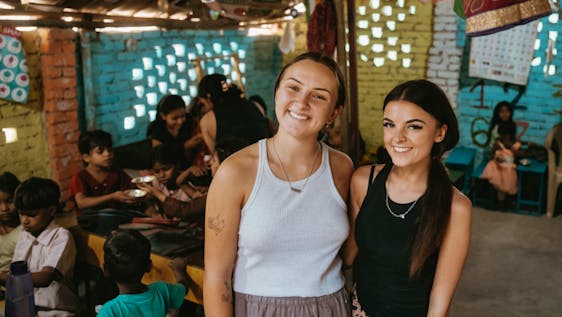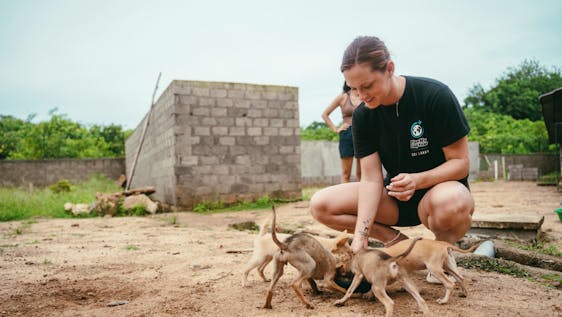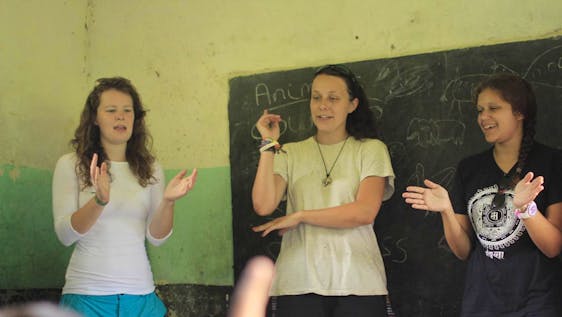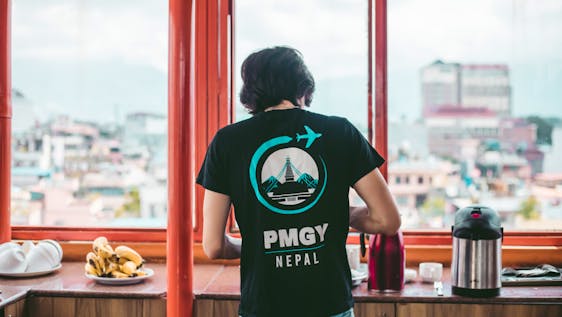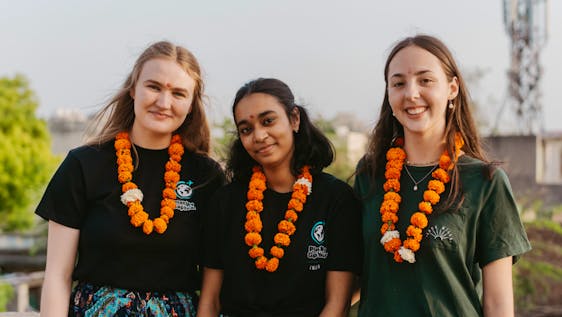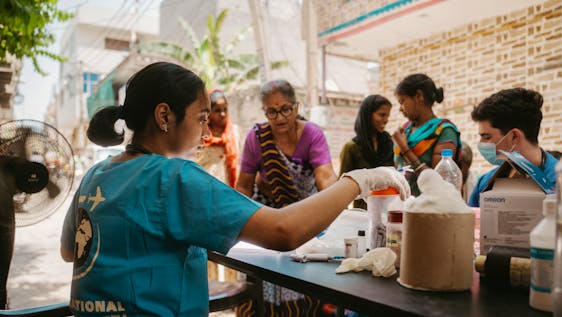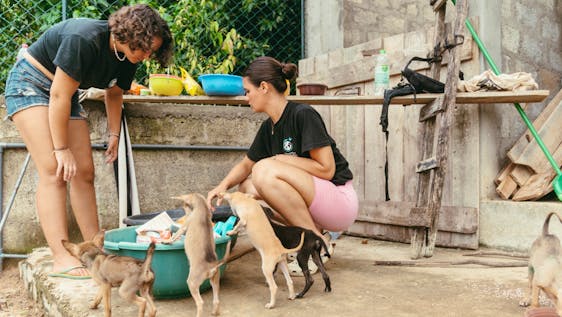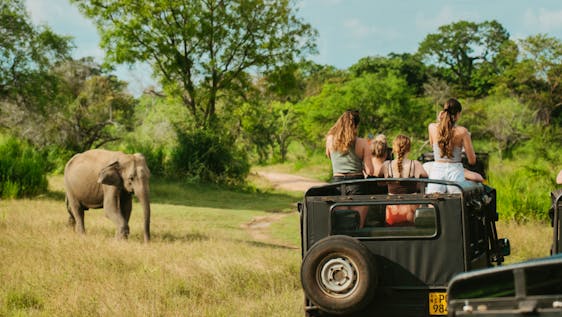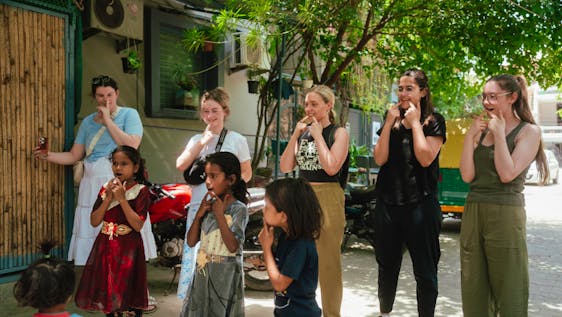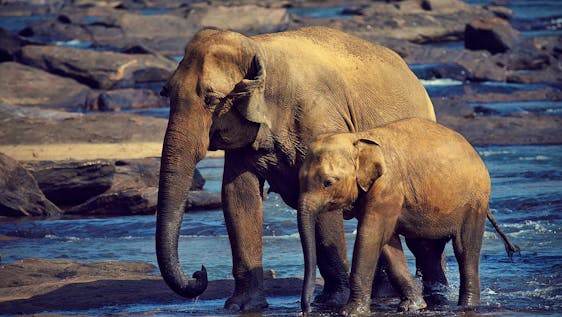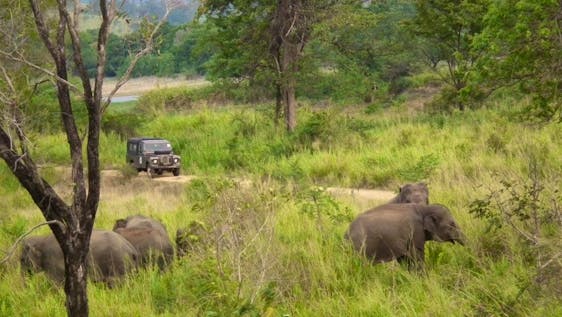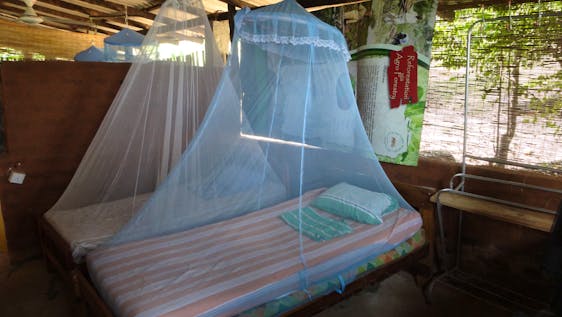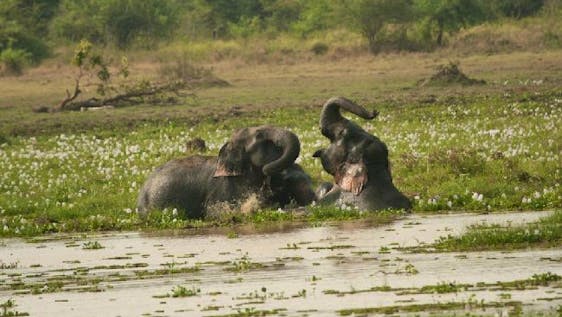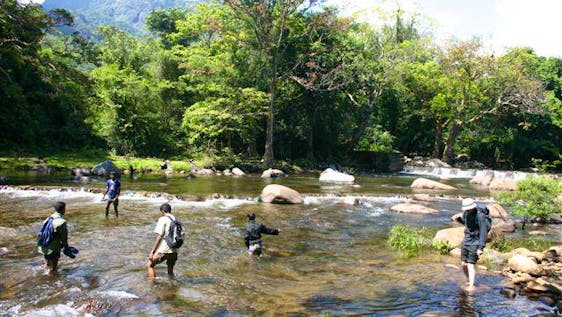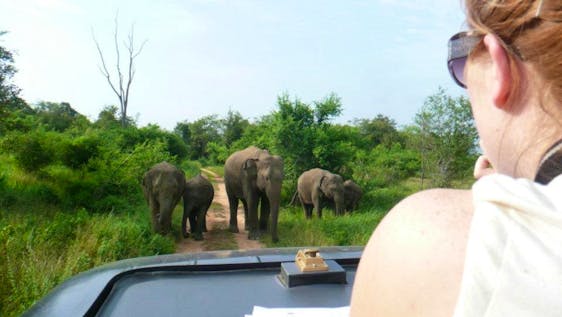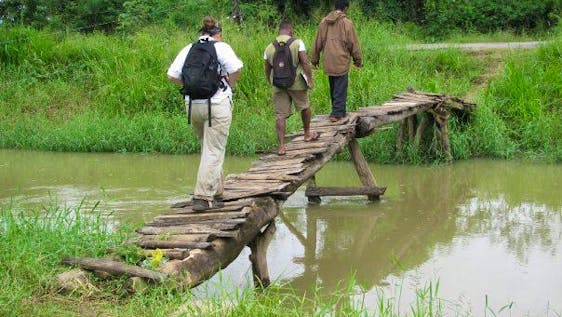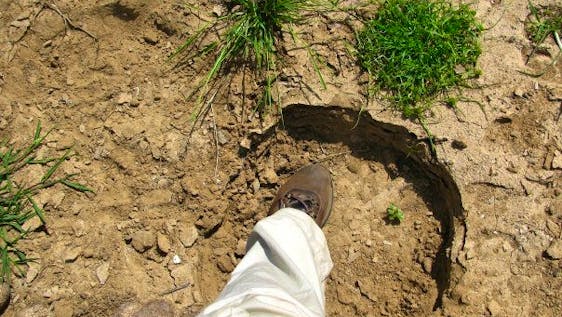Elephant Sanctuary in Sri Lanka
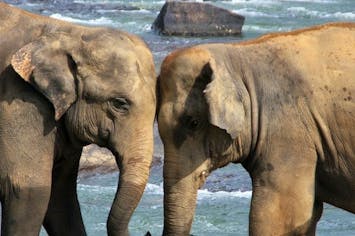
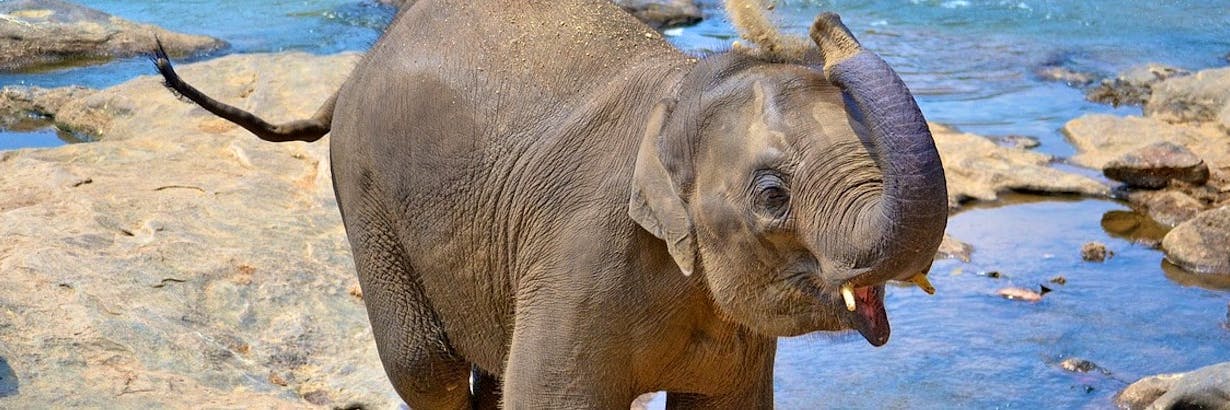
Volunteer at an Elephant Sanctuary in Sri Lanka
An icon for the country’s tourism, the Sri Lankan Elephant draws thousands of wildlife lovers from around the globe to the jewel-shaped island nation. While some elephant sanctuaries, such as the Pinnawala Elephant Orphanage, have been under fire for years, we can give you a verified, animal-friendly alternative for your elephant volunteering experience in Sri Lanka!
As its name suggests, the Sri Lankan Elephant – a subspecies of the Asian Elephant – is endemic to the island of Sri Lanka. You can find this endangered giant in the wild roaming tropical and subtropical forests in Sri Lanka’s North, East, and Southeast.
Do you want to learn about this majestic animal while exploring spectacular natural scenery? Then Sri Lanka is an excellent choice! The island’s relatively small size enables you to explore not only scenic coastlines and white-sand beaches, but also dense jungles and sweeping mountains during your volunteer stay.
Protect and research Sri Lankan elephants in their natural habitat or tend to orphaned, disabled, and abused elephants at a trustworthy sanctuary – whatever you choose, prepare to be blown away!
🐘 Sri Lankan Elephant Conservation Status in 2025
Sri Lanka is home to countless exotic animals including leopards, water buffaloes, and peacocks. The Sri Lankan Elephant, however, is the reason most travelers flock into the country’s national parks and nature reserves.
With an average shoulder height of 3m and weighing over 5 tons, Sri Lanka’s elephants are larger than other Asian elephant species. Their skin is quite dark, but the trunk, ears, face, and belly are often spotted with a pinkish color, which is referred to as depigmentation.
Just like other elephants, the Sri Lankan Elephant is known for its high intelligence, deep feelings, and long-term memory. Led by the most knowledgeable female (often the oldest), a herd usually consists of 12 to 20 of these stunning giants. While males tend to leave the herd after reaching sexual maturity, the females stick together, care for each other, and raise their calves collectively.
Since the 19th century, about 65% of the elephant population in Sri Lanka was lost. Today, the Sri Lankan Elephant is listed as endangered. Experts estimate only up to 4,000 individuals are left in the world.
Once upon a time, the Sri Lankan Elephant used to wander the whole magical island of Sri Lanka. Today, elephant herds can mostly be found in the lowlands of the country’s dry zone. Why?
Habitat Loss
As the planet’s biggest land mammal, elephants require quite some space. In Sri Lanka, scientists measured home ranges of up to 345km² for male elephants.
The megaherbivores spend up to 19 hours a day feeding on grasses, leaves, shoots, barks, fruits, nuts and seeds.They may consume over 150kg of plant matter each day. In order to find these enormous amounts of food elephants need a large habitat with different kinds of vegetation providing them with nutrition throughout the year.
Despite numerous forest reserves and national parks, many wild elephants live outside of these protected areas. Why is that problematic?
Given that Sri Lanka itself is a small island and the country’s population is growing rapidly, you can guess the problem: humans.
Human settlements often expand into unspoiled rainforests and destroy elephants’ habitat. Ancient forests are cut down to build houses, roads, and fields, pushing elephant herds into ever-smaller areas and disrupting their migratory routes. Each year, thousands of hectares of elephant habitat are lost to human development activities. Therefore, deforestation remains the main threat to Sri Lankan elephants.
Human-Elephant Conflict
Elephants face only a few predators, but the most dangerous one is the human. When the herbivores can't find enough plants in their own habitat, they venture into villages and farms in search of food. Enter the Sri Lankan Elephant's appetite for sugar cane, bananas, and other fruits and you have material for a serious human-elephant conflict.
Coexisting with a herd of wild elephants seems effortless – until these elephants stomp through your crops, uproot your trees, and devour your year’s worth of harvest in a matter of minutes.
Farmers, who depend on their harvest to feed their families, often try to defend their crops and end up hurting either the elephants or themselves. Every year, humans kill up to 150 wild Sri Lankan elephants. The statistics for humans don’t look much better: over 50 people fall victim to these human-elephant clashes each year.
Preventing these kinds of conflicts remains one of the largest conservation challenges in all of Asia today.
Illegal Hunting and Trade
Elephants are protected by Sri Lankan law. Killing an elephant bears the death penalty. Capturing wild individuals is also prohibited. But, of course, these regulations don’t completely prevent wildlife crime and live animal trade.
Only about 2% of Sri Lankan elephants have tusks. While this mostly saves the species from ivory hunters, they are still illegally hunted for other products such as meat and leather.
Elephants play a crucial role in Sri Lanka's culture and traditions. The island nation has a long history of domesticating these majestic animals for specific purposes: logging, construction, tourism, and ceremonies. Keeping elephants, especially the adorable calves serve as a status symbol for rich individuals, hotels, and temples.
Owning and domesticating elephants is legal – if you own a valid license. Baby elephants can only be legally obtained from breeding facilities like the Pinnawala Elephant Orphanage. Many people, however, manage to go around these regulations and obtain calves for private use illegally.
Recently, the country’s government introduced tougher legislation concerning captive elephants. According to these new regulations, the large mammals must be provided with fresh fruit and nutritious vegetables, get daily exercise, and can’t be put to work until the age of five.
Unfortunately, that doesn’t save these gentle giants from its owners’ cruelty and abuse. Since some elephant orphanages like the one in Pinnawala are overcrowded with elephants, the government decided to give some of these individuals to private owners and religious organizations.
🐘 Why Are Elephants in Sri Lanka Important?
Sri Lankan elephants are vital for their natural environment. That’s why they are considered a ‘keystone species’: they define their entire ecosystem. By dispersing tree and shrub seeds and by opening up forest clearings, elephants control tree populations and help other species thrive. Without these herbivores, Sri Lanka’s forests would look very different.
But not only animals depend on Sri Lankan elephants – humans do too. Today, Sri Lanka is known as a prime destination for wildlife safaris. Tourists contribute a lot of money to the country’s economy. According to the WTTC, in 2020, tourism employed almost 700,000 people in Sri Lanka. That’s why efforts to protect Sri Lankan elephants are incredibly important for the country’s future.
🐘 How Can We Protect Sri Lankan Elephants?
Current conservation projects focus on preserving the elephants’ habitat and its connectivity, finding solutions for human-elephant conflicts, and improving law enforcement when it comes to elephant trade and poaching.And the good news is: you can contribute to all of these activities during your stay as a volunteer!
In an attempt to safeguard crops and prevent conflict, rangers and farmers are working together to find solutions. Some farmers now build tree houses to spot elephants from far away and then scare them with flares. Others set up electric fences to keep elephants out of their villages and plantations. Nonetheless, the reality is: a hungry elephant will always find a way to get to the food.
Wildlife reserves and national parks are a great start to protect elephants and offer tourists a sustainable way to see elephants in their natural habitat. Elephant sanctuaries and orphanages in Sri Lanka, on the other hand, are necessary to take care of disabled, orphaned, and abused captive elephants that wouldn’t survive in the wild.
Let’s talk about the elephant in the room: Pinnawala Elephant Orphanage. The most famous - and controversial - sanctuary in Sri Lanka is home to about 93 captive elephants. While started with the best of intentions, the orphanage by now has become a big tourist spectacle. Despite obvious harmful activities such as riding an elephant or feeding a calf, there are other details debunking an allegedly animal-friendly management.
Given that these giants need to walk long distances each day, the space at Pinnawala for such a huge crowd of animals is too small. Furthermore, there are not enough Mahouts to take care of all the elephants, resulting in the animals being chained up for extended time periods and being mistreated with sticks to give hordes of tourists closer access.
We do not support conditions like these, which is why we are not featuring Pinnawala Elephant Orphanage and similar institutions on our website. The projects we offer are verified by our team and by our volunteers to give you an amazing, ethical volunteering experience.
🌏 Best Places to Volunteer with Elephants in Sri Lanka
Depending on whether you want to work with wild elephants in a protected area or with captive animals in a sanctuary or an elephant orphanage in Sri Lanka you will be stationed in different parts of the country.
Volunteering with wild elephants will lead you to the deep, green jungles of Wasgamuwa National Park in the central provinces. The park is one of the most biodiverse protected areas in the country and home to large herds of Sri Lankan elephants. Despite a healthy elephant population, Wasgamuwa National Park is home to an abundance of wildlife such as monkeys, water buffaloes, leopards, sloth bears, and hundreds of different bird species.
If you decide to spend your volunteer time helping a mahout care for a retired or disabled elephant, you will either be located in Ambalangoda or in Kegalle. Ambalangoda is a quiet coastal town with golden sand beaches that also runs a turtle conservation project. Kegalle is a bigger town tucked between Sri Lanka's central highlands and southwestern plains. It is a bit busier with tourists as it is close to the Pinnawala Elephant Orphanage (where you won’t volunteer!).
Any of these places will be a great starting point for you to discover this amazing country and its charming locals!
As a tourist in Sri Lanka, you can protect elephants by supporting sustainable, animal-friendly tourism. Say no to elephant rides and other sketchy tour packages!
Places like the Pinnawala Elephant Orphanage are not only overcrowded with tourists, but have also turned into big marketing machines, where it’s hard to track whether the animals’ well-being is still the top priority.
As a volunteer, you have the opportunity to make a direct contribution to the beautiful giants' welfare. Let's have a look what your daily life as a conservation volunteer in Sri Lanka could look like.
📋 What Will I Do as an Elephant Volunteer in Sri Lanka?
The days in a wildlife reserve and in a elephant sanctuary in Sri Lanka vary quite a bit. Take a look at what sort of tasks fit your aspirations and needs. Typical volunteering tasks at a national park include:
- Observe human-elephant conflicts: As you already know human-elephant conflict is one of the main threats to Sri Lankan elephants. That’s why you will be on the front-line to collect data on the elephants’ movements and to monitor and report human-elephant interactions.
- Monitor trails and tanks: Record traces of elephants and their dung found alongside the park's trails and tanks to investigate elephant abundance outside of the park, seasonal variation, and habitat preference. During that activity, you may also encounter other wildlife such as leopards, water buffaloes, and peacocks.
- Test electric fences: Check if the solar-powered electric fences stopping elephants from entering villages are still working and report any irregularities to the maintenance teams.
- Identify elephants: Search for elephants, observe their appearance and photograph them to catalog individual traits for future identification.
- Study sustainable land use: Monitor and evaluate innovative land management systems designed to protect communities from elephant raids.
At an elephant sanctuary in Sri Lanka, on the other hand, these might be your daily tasks:
- Feed the elephants: Twice a day help to harvest, collect and prepare the elephants’ food. You may be able to hand-feed the elephants.
- Bath the elephants: Elephants love bathing and you will assist them twice a day. Scrubbing, washing, and grooming feel like a massage to these titans.
- Walk the elephants: Elephants need to move around a lot every day to stay healthy. Guess what? You will accompany them on their walks! Keep in mind: there will be no elephant riding so you will be walking next to them!
- Maintain the project site: Help to clean elephant enclosures, collect dung and compost it.
- Learn mahout skills: Mahouts are the elephants’ closest companions. They know everything about the character of each individual and they will teach you their ancient knowledge and commands.
- Help vet doctors: Elephants require regular health checks. You may be needed to help the veterinarian during the examinations.
- Engage with kids: Teach children about the importance of ethical handling of animals and animal conservation.
🎁 5 Benefits of Volunteering with Elephants in Sri Lanka
Why should you volunteer in a national park or at an elephant sanctuary in Sri Lanka? We’ve got plenty of reasons for you.
Hang out with the largest animal on land
Engaging with these giant creatures is very special. You will experience their emotional intelligence first hand and learn more about these animals than you can read in any book.
Meet Sri Lanka’s wonderful, charming people
Many travelers rave about how welcoming the local people are to foreigners. Get ready to be received with big smiles and open arms!
Spend some time in nature
City life can be exhausting. Refresh your senses by wandering through pristine rainforests and connecting with Mother Nature and her amazing creations.
Get addicted to the local cuisine
Dive into the mouth-watering world of flavorful curries, fresh vegetables, and exotic fruits. Many dishes are also vegan-friendly so you can even take your vegan friend!
Support sustainable tourism
By volunteering for a project that has the elephants' well-being at heart, you help local people make a living by doing something to preserve the environment. Get on it!
EVALUATED NE
DEFICIENT DD
CONCERN LC
THREATENED NT
ENDANGERED CR
IN THE WILD EW
 Hotspots
Hotspots
 Elephant Conservation
Elephant Conservation
 Activities
Activities
 Sri Lanka
Sri Lanka
 Asian Elephant
Asian Elephant
 Asia
Asia
 Southern Asia
Southern Asia
 Sri Lankan Elephant
Sri Lankan Elephant
 Volunteer and Travel
Volunteer and Travel
 Voluntourism
Voluntourism
 Monastery
Monastery
 Delhi
Delhi
 Himalaya
Himalaya
 Jaipur
Jaipur
 Kathmandu
Kathmandu
 Animal
Animal
 Wildlife Conservation
Wildlife Conservation
 Elephant Research
Elephant Research
 National Park
National Park

